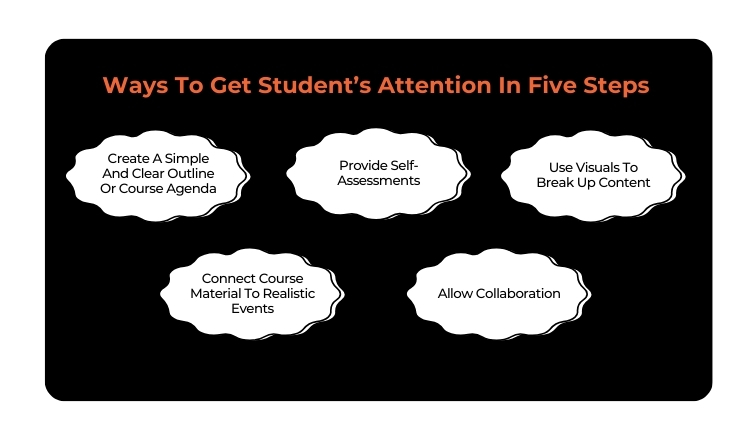A Five-Step Hack for Teachers to Get Student’s Attention-Look For The Third Point
7 Mins Read
Published on: 11 April 2023
Last Updated on: 21 November 2024

Teachers are using technology significantly more than in the past. Most online graduate courses are delivered entirely online.
Teachers frequently use online websites and programs for instructional purposes. It includes checking social networking sites or email accounts. However, there is a method to keep students interested. You can mix digital information and technology into your teaching
Students’ attention spans and attitudes toward educational institutions have shifted considerably. Millennials, born between 1980 and 2000, are increasingly entering the workforce. Thus, instructors must be aware of specific fundamental characteristics in their students.
Getting students’ attention is difficult since they are accustomed to obtaining information with a few clicks. It might be challenging when you’re attempting to get them to listen in class.
Ways to Get Student’s Attention in Five Steps

Whether you are a novice teacher or a seasoned professional, you may seek new methods to engage students. It often takes more than a lesson plan to pique students’ interest in your teaching.
Gaining and maintaining your students’ attention is a critical component of teaching. The more you can interest your students in their studies, the more excited they will be. Let’s look at strategies for capturing your students’ attention in class. You can create successful learning environments that engage the next generation of workers.
1. Create A Simple And Clear Outline or Course Agenda
You, as an educator, are entirely knowledgeable. You have all the abilities. Even so, if you don’t have a clear strategy for how you’ll present it, your students will become bored and tune out. That is why developing a basic and straightforward plan for your online course is critical.
Online courses for educators allow instructors to broaden their knowledge base. It builds skills that will help them enhance their teaching techniques. Still, you must grasp what your students want and desire from the course to keep them involved.
Making an overview or course agenda entails more than writing down what you intend to cover. It also entails considering how one part will flow into the next. Thus, students will know how to interact as a whole.
Your outline should be adaptable enough to use it as-is or adjust it as needed, depending on student input. The following aspects should be included in a clear framework and course agenda:
- The course objectives are established
- You give students an outline of what they may expect from this course
- Outline the resources that are accessible to them (e.g., textbooks, videos, etc.)
- You explain the course structure, including topics covered, assignment due dates, etc.
The more thorough your plan, the better it will be for learners to get along with the sessions in your program. If you give students these details upfront, students may be able to stay motivated and interested during your online session.
2. Provide Self-Assessments
Whatever distracts your students, it is critical to discover strategies to engage them in the content.
Self-assessments are one technique for instructors to bring their students back into focus. These assessments allow teachers to step back and examine what their students are learning. It will enable them to change their teaching techniques accordingly.
Self-evaluations are helpful tools for instructors. These assessments test student achievement. It helps the student identify those that need more instruction and correction. Teachers can also use self-assessments to know their performance. They can improve their teaching strategies based on what they learn from their students.
Teachers encourage them to take control of their learning through self-assessments. It contributes to creating a good classroom climate in which students feel empowered by their participation in the classroom. This makes students more likely to participate and engage with the delivered content.
You have many obligations and time demands as an instructor. It may be challenging for you to find the time required to do successful self-evaluations. Yet, several resources are available that can make this work much easier than you may imagine.
Indeed, many instructors have discovered that employing self-assessments assists them in determining what needs more practice to reach their goals.
You may even find that some kids struggle with one idea but thrive at another. It can assist teachers in adjusting their teachings so that everyone gets what they need from class time.
3. Use Visuals to Break Up Content

Teachers and educators always look for new methods to make their classes more interesting. They want their students to be enthusiastic about their classes. Yet, they want them to be focused on their studies. You may accomplish this by using images to break up your material.
Breaking up material using visuals is a terrific method to keep students engaged and interested in your presentation. It’s essential when conducting courses online since students can’t see your emotions or hear your voice.
Visuals are also quite beneficial in assisting kids in learning new knowledge. When you utilize visual components, such as photographs or films, they retain the material better than if you just read it.
Visuals assist students in understanding complicated ideas that might otherwise be difficult to grasp. For instance, if you’re talking about how water molecules join together to produce hydrogen bonds, providing a graphic of the process might help them (and you!) understand it much better.
You can use images that are relevant and familiar. Choose photographs that are linked to your lesson plan or topic. If you’re teaching about the history of dance in the twentieth century, use photos of dancers from each decade. Or, if you’re teaching about ancient Egypt, consider utilizing Egyptian hieroglyphs rather than plain text.
Make sure that your photographs are clear and well-lit. Students can focus more readily on readings if they can see them well! Where feasible, utilize captions. Captioning allows students to read along with the text while still seeing it enough for simple understanding.
4. Connect Course Material to Realistic Events
If you’re a teacher, you know how difficult it can be to convince your kids to pay attention at times. It’s much more difficult when students have to complete an online course. Online graduate courses for teachers can help you attract their attention.
Videos are the finest method to tie course material to real-world happenings. They are also a terrific way for you, as an educator, to capture your students’ attention. They’re an excellent method for kids to notice what’s happening in their environment.
Sometimes, use movies in your teaching materials to encourage your students to listen!
It is significant because it enables your students to understand how their class learning may be used outside the classroom. Additionally, it demonstrates how students can take what they learn and make it their own. It is one of the most critical talents every student will need when they reach adulthood.
Yet, if you can tie course material to practical occurrences, you will be able to do so. You’ll be able to offer material to your students in a relevant and exciting way. It makes learning an engaging experience and keeps their interest in what they are doing.
As time passes, you realize that the classroom is more than just providing kids with the information they need to succeed. It is also about assisting children in developing abilities that they will use throughout their lives.
5. Allow Collaboration
Collaboration is recognized as one approach professors use to engage students’ attention in an online graduate teaching program. Instructors frequently employ collaboration to engage students, mainly when undertaking activities or projects requiring more than one student or group to work together on something.
Collaboration is also crucial since it allows students to work together and assist one another in learning new concepts or abilities without depending as heavily on the teacher. It increases students’ confidence in what they know and gives them control over their learning process.
A collaborative effort is essential to learning, but getting kids to interact in the classroom may take time and effort. You can use collaborative tools like Google Documents or Basecamp to teach online. These applications enable students to collaborate on projects from anywhere at any time.
Cooperation also allows students to develop communication skills, which will be helpful when they enter the industry. Collaboration activities urge students to communicate with others to finish assignments, which is crucial to how they will operate in the future.
Online graduate courses for teachers should allow students to collaborate and exchange ideas. This can help build on one another’s work while learning from another’s criticism.
Final Thoughts
Educational technology provides infinite ways to attract and maintain students’ attention, and different strategies will be more or less effective for other groups of learners.
The finest course content, regardless of format, is exciting and participatory. Technology cannot replace instructors. Educators may draw students’ attention and stimulate future learning beyond course participation by using it in classes.
A straightforward, well-defined structure or agenda will benefit your student’s education. Utilizing visuals is a terrific method to organize your ideas and points regarding the course subject and keep the entire class engaged. Moreover, self-assessments may be converted into quizzes that evaluate your student’s understanding of the course material.
As a result, while employing technology to grab attention, instructors must be progressive. The more relevant and imaginative their applications, the more students will find the content intriguing by relating it to real-world experiences.
Getting students interested in a subject is a terrific way to help them learn. Remember these pointers when you create your lessons or course outlines for the coming semester.
read Also:


















Comments Are Closed For This Article